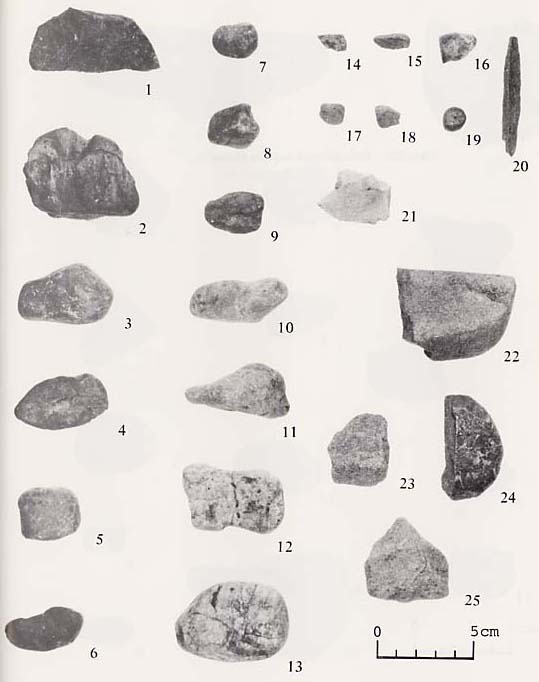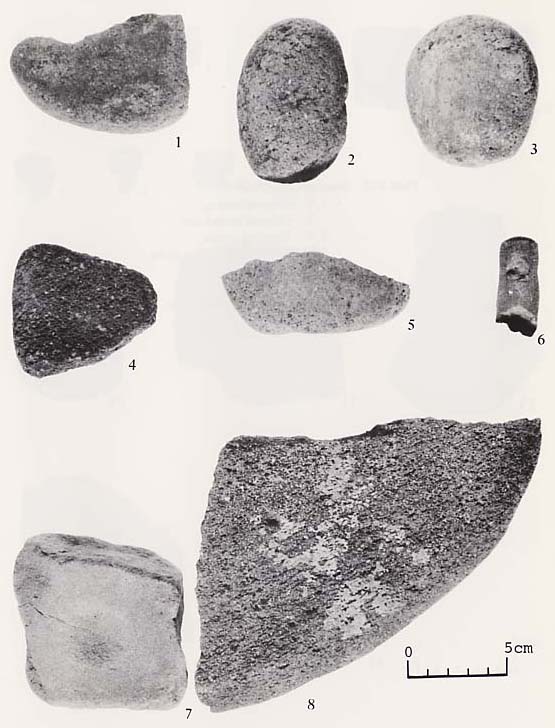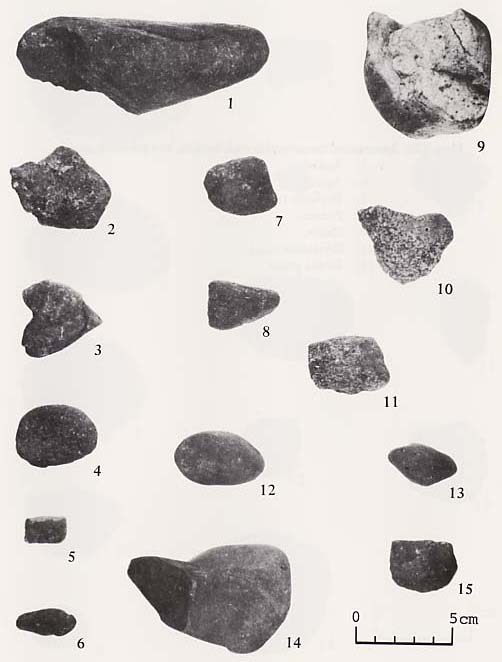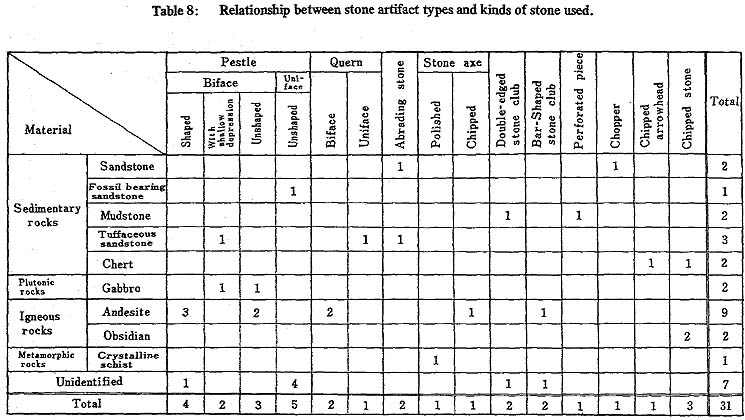The total number of the rocks collected from the deposits is four-hundred forty. The identifiable number is three-hundred ninty-five, falling into twenty-seven types, including two minerals. Thirty-one pieces are modified for use. The rest are gravel without any signs of artificial shaping.
1. Identification
(a) Sedimentary Rocks (Plate XI)
- Sandstone (Plate XI:22-24):
- A total of twenty-three pieces from Layers B-G with the greatest occurrence in Layer F. Two were used as abrading stones and one as a chopper.
- Fossil Bearing sandstone:
- One from Layer B, used as a uniface type pestle (Fig. 7:3, Plate XV:6):
- Muddy sandstone:
- One piece from Layer E.
- Mudstone (Plate XI: 14-.21):
- A total of sixteen pieces from Layers B, C, and E. One was used as a double-ended stone club and one is a perforated pebble.
- Siliceous shale:
- One piece from Layer B.
- Shale (Plate XI:7-13):
- A total of fifty-five pieces found only in Layers C and F, and especially common in the latter. None appear to have been modified for use.
- Tuffaceous sandstone (Plate XI: 25):
- Six pieces, one pestle, one quern, one abrading stone, and three unmodified.
- Chert (Plate XI: 1-6):
- Sixty pieces from Layers B-F. One is a chipped arrow-head. The rest arepebbles and breccias.

Figure 7: Stone artifacts. Pestles of biface type with two grinding surfaces (1,4) and uniface type with single grinding surfaces (2,3,5) (Scale 1/2).
1 (K-5); Pestle of biface type. Shaped block. Round in outline and roughly rectangular in cross section. Grinding surfaces parallel and slightly convex. From layer C.Material, andesite (Plate XIV: 1).
2 (K-7); Pestle of uniface type. Unshaped block. Roughly rectangular in outline and oval in cross section. Grinding surface convex. From layer C. Material, unidentified (Plate XIV :9).
3 (K-l); Pestle of uniface type. Unshaped block. Grinding surface at the distal end. Convex. From layer B. Material, fossil bearing sandstone (Plate XV:6).
4 (K-6); Pestle of biface type. Unshaped block. Roughly round in outline and oval to rectangular in cross section. One of grinding surfaces convex and another slightly concave. From layer C. Material, gabbro (Plate XIV:7).
5 (K-16); Pestle of uniface type. Unshaped block. Round in outline and roughly oval in cross section. Grinding surface convex. From layer D. Material, unidentified (Plate XV:3). |

Plate XI: Sedimentary rock samples (Scale 1/2).
1-6; Chert,
7-13; Shale,
14-21; Mudstone,
22-24; Sandstone,
25; Tuffaceous sandstone |

Plate XV: Stone artifacts (Scale 1/2).
1-3,5,6; Pestles, 4,7,8; Querns |
(b) Plutonic Rocks (Plate XII)
- Gabbro (Plate XII:11-15)
- A total of twenty-three pieces found almost evenly throughout Layers B through F with a minor peak in Layer B. Two are pestles.
- Diorite (Plate XII: 10):
- One piece from Layer C.
- Granite (Plate XII:9):
- One piece from Layer C.
- Quartz porphyry (Plate XII: 1-8):
- A total of one-hundred forty-four pieces. The most abundant rock. Found evenly throughout Layers B through G, but with the greatest number in Layer F.

Plate XII: Plutonic rock samples (Scale 1/2).
1-8; Quartz porphyry,
9; Granite,
10; Diorite,
11-15; Gabbro |
(c) Igneous Rocks (Plate XIII)
- Andesite (Plate (XIII: 1-5):
- A total of thirty-two pieces from Layers B -F, most abundant in Layer F. Nine are classified as pestles, querns, stone axes or bar-shaped stone clubs. Andesite is the most common utilized rock.
- Dacite (Plate XIII :10):
- One piece from Layer F.
- Scoria
- One piece from Layer B.
- Dacitic pumice
- One piece each from Layers B and E.
- Pumice (Plate XIII: 8-9):
- Two pieces from Layer D.
- Andesitic tuff:
- One piece from Layer B.
- Rhyolitic tuff (Plate XIII: 7):
- One piece from Layer B.
- Obsidian (Plate XVI: 1,7):
- One piece each from Layers B and C. Both are artificially chipped.

Plate XIII: Igneous and metamorphic rock samples, and others (Scale 1/2).
1-5; Andesite,
6; Agata,
7; Rhyolitic tuff,
8-9; Pumice,
10; Dacite,
11; Crystalline schist,
12-14; Biotite gneiss |

Plate XVI: Stone artifacts (Scale 1/2).
1,7,9; Chipped stones,
2; Chipped arrowhead,
3,4; Abrading stones,
5,6; Double-edged stone clubs,
8; Perforated pebble,
10. 12; Stone axes,
11. 13; Bar-shaped stone clubs,
14; Chopper |
(d) Metamorphic Rocks (Plate XIII)
- Biotite gneiss (Plate XIII: 12-14):
- A total of seventeen pieces, none are modified.
- Crystalline schist (Plate XIII: 11)
- Two pieces from Layer C. One of them is used as a stone axe.
(e) Others (Plate XIII:6)
- Agate (Plate XIII: 6)
- One piece from Layer E.
- Quartz:
- One piece from Layer B.
2. Remarks on the Rock Samples
Numerous kinds of rocks were collected in the midden deposits. However, their source is neither the midden deposits nor the Pleistocene deposits (Kanto Loam) of the site. Therefore, itis probable that these rocks (gravel) were brought in from the other places, possibly the mountain areas in the Kanto Region.
Of twenty-four kinds of rocks classified, nine kinds include a few pieces with signs of artificial shaping (Tables 6,8) - sandstone, fossil bearing standstone, mudstone, tuffaceous sandstone, chert, gabbro,andesite,obsidian and crystalline schist. The rest are pebbles and breccia without any artificial shaping. These make up the bulk of the pieces (229). It is not known if these were thrown away before making them into stone implements, or if they were thrown away as waste pieces. Especially numerous in this category of unmodified rocks are quartz porphyry (114 pieces) and shale (55 pieces) (neither kind includes any instance of being modified). Shale is restricted to Layers C and F.

Table 6: Frequency of stone samples, including stone artifacts, by layer. |

|